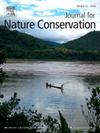制定保护价值综合指数以确定保护区的保护状况:马来西亚半岛克劳野生动物保护区和 Tasek Bera 拉姆萨尔湿地的案例
IF 2.2
3区 环境科学与生态学
Q2 BIODIVERSITY CONSERVATION
引用次数: 0
摘要
在马来西亚半岛,对保护区保护状况进行评估的形式和背景各不相同,导致评估结果不一致,给保护区管理者造成误解和不确定性。此外,这些评估在很大程度上依赖于保护区内部的保护价值,尽管其价值也受到外部环境的影响。在这方面,使用保护价值综合指数(CICV)为更实际地评估保护状况提供了机会。因此,本研究的目的是开发一个 CICV,以确定马来西亚半岛两个保护区(即克劳野生动物保护区和塔塞克贝拉拉姆萨尔遗址)的保护状况。保护价值评估以保护区内外的土地利用/土地覆被图为基础,采用了三个景观尺度指标,即自然度、破碎度和连通性。通过分析分层过程,将这些指标结合起来,得出每个保护区内外的 CICV。通过敏感性分析获得可接受的稳健性值,从而计算出 CICV 分数。然后,对每个保护区的内部和外部地点进行合并,计算出净 CICV。根据内部、外部和净 CICV 分数,以 "非常危急"、"危急"、"中等"、"良好 "和 "极佳 "为标记的临界值表来确定该地区的保护状况。克劳野生动物保护区内的 CICV 为 88.4%,表明保护状况为 "极佳",而保护区外的状况为 "危急",CICV 为 35%。该地区的净CICV为64.29%,净保护状况为 "良好"。Tasek Bera 拉姆萨尔遗址内部和外部的 CICV 分别为 35 % 和 21.34 %,均为 "危急 "保护状态。净 CICV 为 22.52%,表明净保护状况为 "危急"。结果表明,保护区的外部景观是影响保护区净保护状况的一个威胁。因此,全面的保护状况评估需要一个综合指数,将来自外部的保护价值整合起来,帮助保护区管理者轻松理解和解释评估结果,从而有效协调保护规划。本文章由计算机程序翻译,如有差异,请以英文原文为准。
Developing a composite index of conservation value to determine the conservation status of protected areas: The case of the Krau Wildlife Reserve and Tasek Bera Ramsar Site, Peninsular Malaysia
In Peninsular Malaysia, the various forms and contexts of assessing the conservation status of a protected area has led to inconsistent results, causing misunderstanding and uncertainty among protected area managers. Furthermore, these assessments rely heavily on the conservation value inside the protected area, despite the fact that its value is also influenced by the external environment. In this regard, using a composite index of conservation value (CICV) provides the opportunity for a more practical assessment of conservation status. Therefore, the objective of this study was to develop a CICV to determine the conservation status of two protected areas in Peninsular Malaysia, i.e., the Krau Wildlife Reserve and Tasek Bera Ramsar Site. Land use/land cover maps inside and outside the protected areas, developed using Landsat images from 2014, were the basis for the conservation value assessment, which employed three landscape scale indicators, i.e., naturalness, fragmentation, and connectivity. Through an analytical hierarchical process, the indicators were combined to develop a CICV inside and outside each protected area. Acceptable robustness values obtained through sensitivity analysis enabled the calculation of the CICV scores. For each protected area, the internal and external sites were then merged to calculate a net CICV. The inside, outside, and net CICV scores were used to determine the area’s conservation status on a critical value scale with the markers ‘very critical’, ‘critical’, ‘moderate’, ‘good’, and ‘excellent’. Inside the Krau Wildlife Reserve, the CICV was 88.4 %, indicating an ‘excellent’ conservation status, while its outside status is ‘critical’ with a CICV of 35 %. The net CICV of this area was 64.29 %, yielding a ‘good’ net conservation status. The CICV inside and outside Tasek Bera Ramsar Site were 35 % and 21.34 % respectively, both of which represent a ‘critical’ conservation status. The net CICV was found to be 22.52 %, suggesting that the net conservation status is ‘critical’. The results show that the external landscape of protected areas is a threat that influences the areas’ net conservation status. Therefore, a comprehensive conservation status assessment requires a composite index that integrates conservation values from the outside to help protected area managers easily understand and interpret findings, and thus, effectively coordinate conservation planning.
求助全文
通过发布文献求助,成功后即可免费获取论文全文。
去求助
来源期刊

Journal for Nature Conservation
环境科学-生态学
CiteScore
3.70
自引率
5.00%
发文量
151
审稿时长
7.9 weeks
期刊介绍:
The Journal for Nature Conservation addresses concepts, methods and techniques for nature conservation. This international and interdisciplinary journal encourages collaboration between scientists and practitioners, including the integration of biodiversity issues with social and economic concepts. Therefore, conceptual, technical and methodological papers, as well as reviews, research papers, and short communications are welcomed from a wide range of disciplines, including theoretical ecology, landscape ecology, restoration ecology, ecological modelling, and others, provided that there is a clear connection and immediate relevance to nature conservation.
Manuscripts without any immediate conservation context, such as inventories, distribution modelling, genetic studies, animal behaviour, plant physiology, will not be considered for this journal; though such data may be useful for conservationists and managers in the future, this is outside of the current scope of the journal.
 求助内容:
求助内容: 应助结果提醒方式:
应助结果提醒方式:


